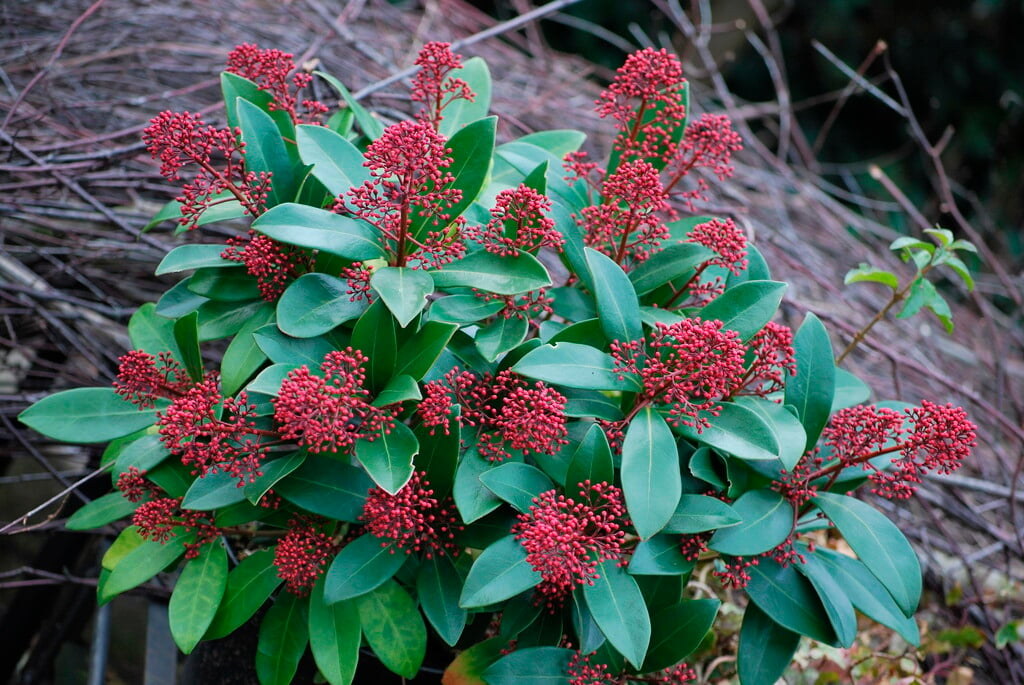Skimmia japonica
Japanese skimmia
A variable, evergreen, densely-branched, dome-shaped shrub, low and creeping or erect, from 0.5m to 7m in height (but typically up to 1.5m in cultivation), with slightly-aromatic, dark green, leathery, obovate to elliptic leaves. White flowers in spring, sometimes flushed pink or red on the outside, appear in panicles at the ends of branches; male flowerheads are large and conspicuous, up to 8cm long, and very sweetly-scented, while the smaller fragrant female flowerheads are followed, if pollinated, by brilliantly bright red fruits, 8mm across, which usually last until the next flowers appear the following spring
Size
Ultimate height
1.5–2.5 metresTime to ultimate height
5–10 yearsUltimate spread
1–1.5 metresGrowing conditions
Moisture
Moist but well–drainedpH
Acid, Alkaline, NeutralColour & scent
| Stem | Flower | Foliage | Fruit | |
| Spring | White | Green | ||
|---|---|---|---|---|
| Summer | Green | Red | ||
| Autumn | Green | Red | ||
| Winter | Green | Red |
Position
- Full shade
- Partial shade
Aspect
South–facing or North–facing or West–facing or East–facing
Exposure
Sheltered Hardiness
H5Botanical details
- Family
- Rutaceae
- Native to GB / Ireland
- No
- Foliage
- Evergreen
- Habit
- Bushy
- Potentially harmful
- Fruit are ornamental, not to be eaten. Wear gloves and other protective equipment when handling. Pets: Fruit are ornamental, not to be eaten - see the HTA guide to potentially harmful plants for further information and useful contact numbers
- Genus
Skimmia are compact evergreen shrubs with simple, aromatic leaves and terminal panicles of small white or yellowish flowers followed, on fertilised female plants, by shiny red berries; most have male and female flowers on separate plants
- Name status
Correct
- Plant range
- China, Japan
How to grow
Cultivation
Grow in humus-rich, light, rich, moist but well-drained soil in partial or full shade; will grow best in neutral or acidic soils, but will also thrive in humus-rich alkaline soils; plant both male and female plants to get fruits
Propagation
Propagate by seed, sown in a cold frame in autumn, or sown outside in spring; by softwood cuttings of new growth in early summer and given bottom heat; by semi-ripe cuttings in a cold frame in late summer; or by layering
Suggested planting locations and garden types
- Cottage and informal garden
- City and courtyard gardens
- Wildlife gardens
- Low Maintenance
- Flower borders and beds
- Hedging and screens
Pruning
Pruning group 1 (little or no pruning of trees and shrubs) or pruning group 8 (early-flowering evergreen shrubs)
Pests
May be susceptible to scale insects, and to vine weevil when grown in containers
Diseases
May be susceptible to Phytophthora and honey fungus
Love gardening
Sign up to receive regular gardening tips, inspiration, offers and more
View our Privacy Policy
Get involved
The Royal Horticultural Society is the UK’s leading gardening charity. We aim to enrich everyone’s life through plants, and make the UK a greener and more beautiful place.
